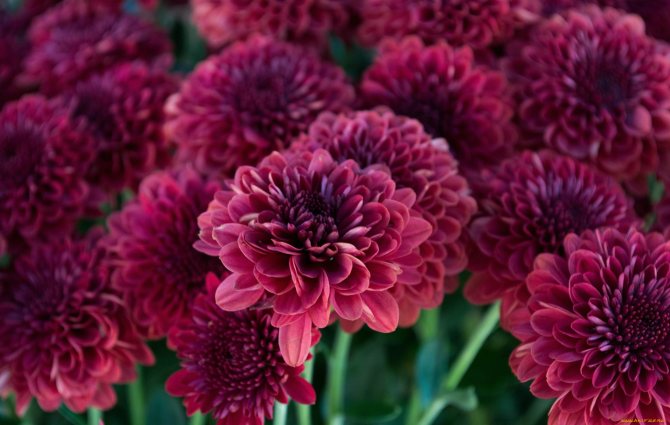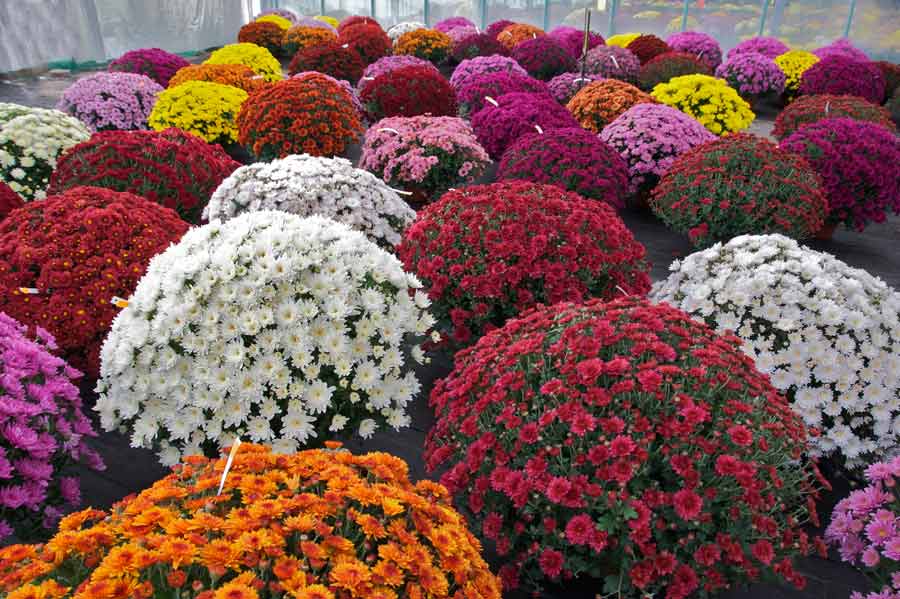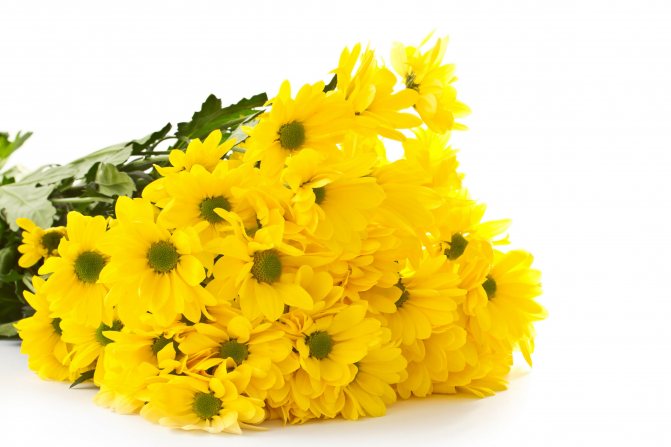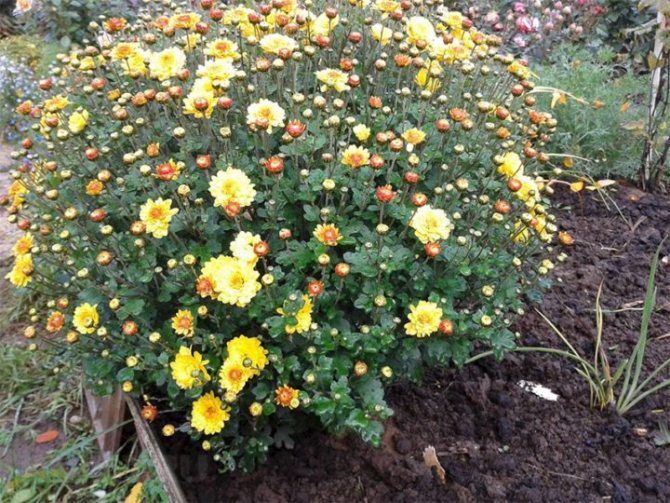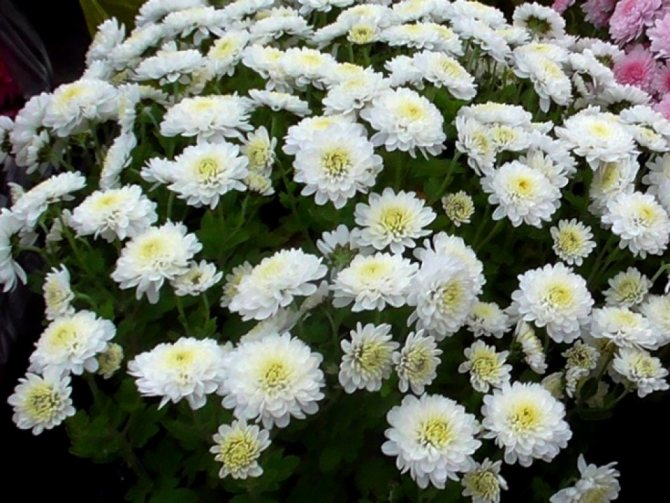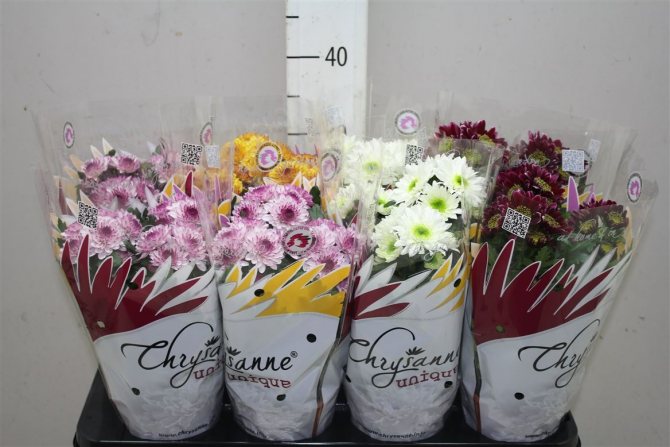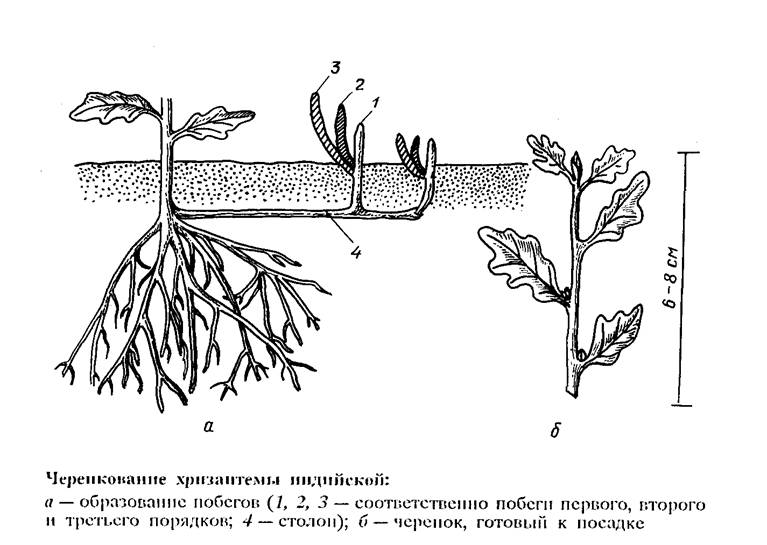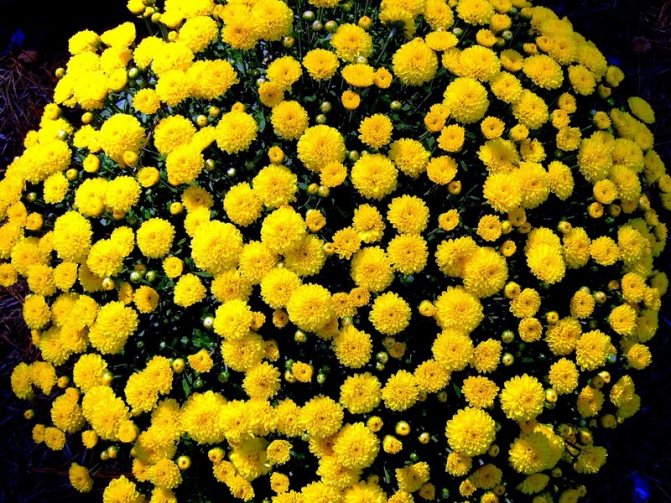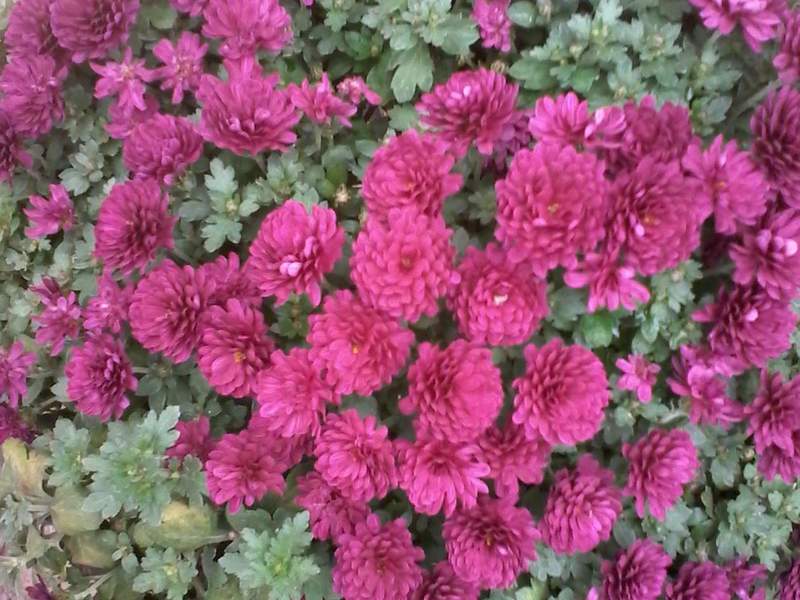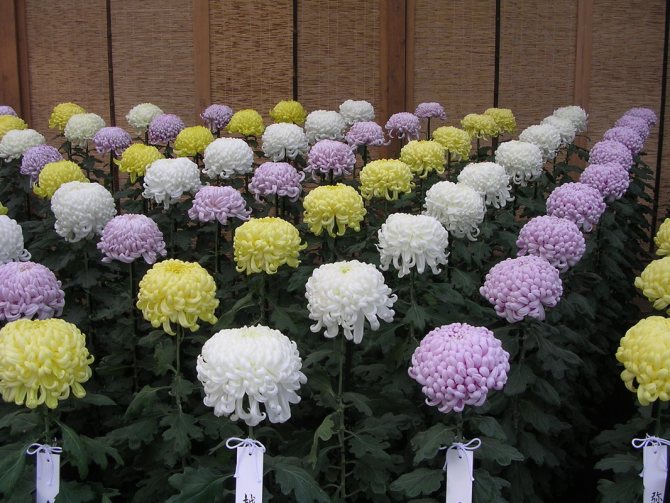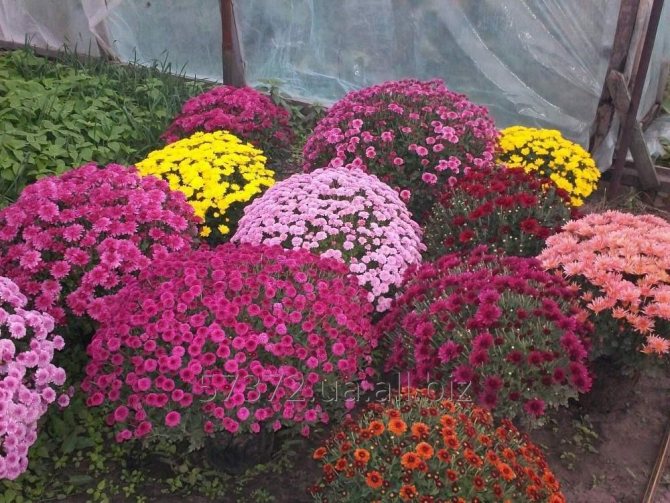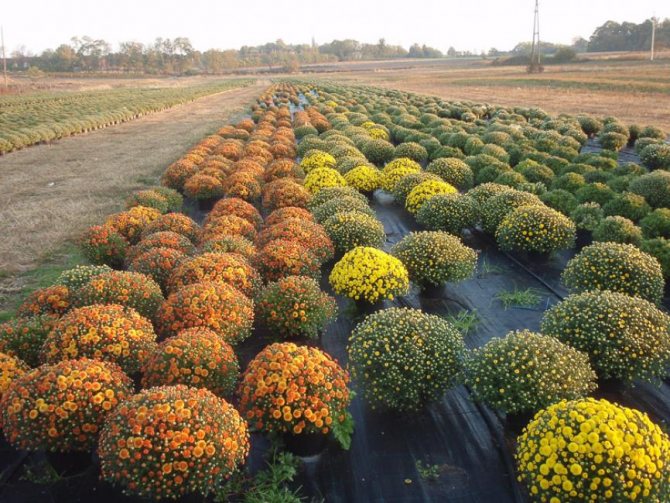All the secrets of spherical chrysanthemum, its cultivation and care will not take much time and effort. These wonderful plants bloom early, they are unpretentious and give your garden an unusual look.
Chrysanthemum globular or Chrysanthemum Multiflora is a relatively recently bred hybrid. Its height is about 50 cm and amazes observers with its bizarre shape. The fact is that the inflorescences take the shape of a regular ball and almost do not require pruning. The foliage is not visible at all, which means that wonderful flower balls will appear in your garden. In addition, they are unpretentious in care and can please the eye for 3 months: from August to October.
Description of the multiflora variety

Chrysanthemum Multiflora (Chrysanthemum multiflora) - a representative of the family Compositae small-flowered type. As it grows, the chrysanthemum independently takes the shape of a regular ball from flowers where foliage is almost invisible. Due to this property, the plant received a second name - single-flowered spherical chrysanthemum. Despite the fact that the variety is quite new, it already has over 4000 hybrids of various colors.
One of the reasons Multiflora is popular in garden design is the ability to match the plant to the desired height. Among its varieties are:
- undersized, whose height is 20-30 cm;
- medium-sized, 30-40 cm in height;
- tall, with a height of 60-70cm.
Important. Thanks to this variety, spherical chrysanthemums fit perfectly into any interior. In addition, stunted chrysanthemums are suitable for growing in pots. They can decorate not only a garden, but also a balcony, or even a room.


Multiflora also differs in terms of flowering time:
- early flowering, begins to bloom in August;
- medium flowering, flowering begins in September;
- late flowering, from late September or early October.
With a combination of several varieties of globular chrysanthemums, you can enjoy flowering from late summer to the very frost.
Another important advantage of the variety is the ability not to prune the plant, because the shape of the ball is genetically incorporated into it. Sometimes gardeners recommend pinching the top of the flower when it already has 2-4 pairs of leaves, so that the shape is perfect. But even without pinching, Multiflora will round enough.
But they have spherical chrysanthemums and a significant disadvantage. The plant is absolutely not resistant to cold. In the case of little snow and frosty winters, the chrysanthemum can freeze out, despite the shelter. Therefore, you should not leave them for the winter in the ground. In order to preserve the plant until next year, special conditions must be created for it.
Diseases and pests
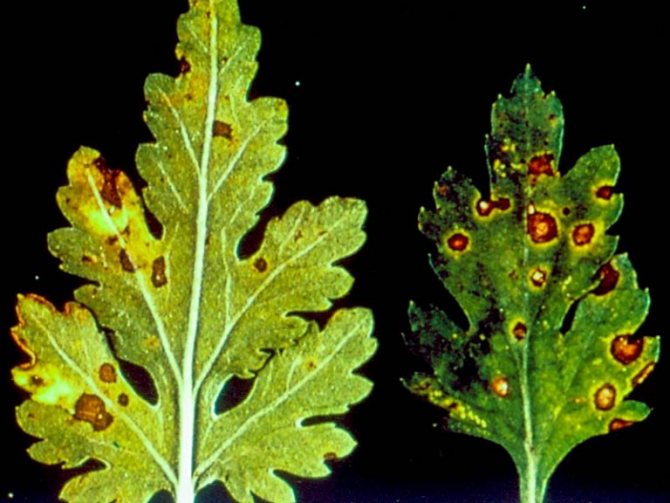

Although this flower is considered a plant that is quite resistant to various diseases, it still does not have one hundred percent immunity. Sometimes it happens that the leaves begin to turn black, and the stem is bare from below. The reason for this is powdery mildew. It can appear if the bush is very thick or very moist soil. Also, the appearance of powdery mildew can provoke a sharp temperature drop. Copper-based drugs help fight this disease. It will be useful to carry out preventive spraying at the beginning of summer.
Tagetes erect: varieties, growing a flower and care
There are other diseases and pests that can damage the plant. The following methods will help to save the bushes:
- If the chrysanthemum is attacked by spider mites and aphids, it should be watered more often. This type of pest does not tolerate moisture.
- Caterpillars must be regularly removed from the bushes of this flower. To destroy caterpillars, aphids, leaf rollers, I use drugs such as Aktar, Aktellik or Fitoverm. These can be purchased at gardening stores.
- There are harmful organisms in any soil. So that the plants do not get sick, it is advisable, after each rain or watering, to process them with Quadris or Previkur.
- To prevent the roots from rotting, it is recommended to add Fitosporin to the water that is watered with flowers.
- Sometimes the leaves on the bushes turn brown and then dry out. This suggests that the chrysanthemum was burned. In this case, the bush should be removed from the garden and burned.
Preparing Multiflora for wintering
Like any artificially bred hybrid, Multiflora has lost some of the properties inherent in the rest of the species. Most varieties of chrysanthemums can easily tolerate the cold, and they can be safely left for the winter in the open field. Multiflora, on the other hand, can survive the winter like that only in the southern regions. And in central Russia, it should be dug up in the fall.... And in order for the flowers to stand longer, starting in October it is better to cover them with plastic at night, especially if frosts are expected.
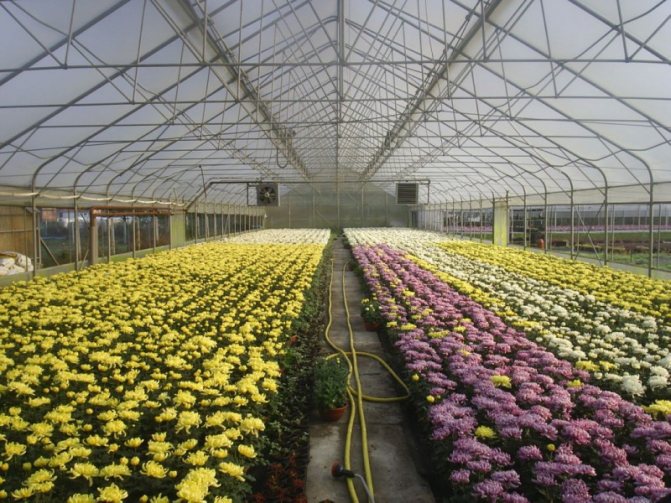

To prepare for winter, globular chrysanthemums need dig up before the first frost... Depending on the region, this could be the beginning or end of November. To do this, cut the stems of the chrysanthemum, and place the roots in boxes with soil. By analogy with dahlias, these boxes are stored in a dark room, observing the temperature regime in the range from +3 to -5 degrees. The moisture content of the earth should be moderate, bad if it is too wet or dry. Chrysanthemums are exposed in the sun in April so that buds have formed by the time they are planted in the ground.
Chrysanthemums that are grown in pots hibernate in the same way. In winter, the air in the apartments is too warm and dry for these plants, so in the fall the indoor Multiflora is cut off and stored in a dark, cool place.
Preparing for winter - the only moment in breeding Multiflora that will require some effort on your part... Otherwise, the cultivation of these flowers does not bring much trouble. Now you know how best to preserve the globular chrysanthemum in winter. But in order for you to have something to save, you need to know how to properly plant a flower.


Chrysanthemum digging and storage
They begin to extract the chrysanthemum bush from the soil when the temperature does not rise above 0. The bush is dug out with a pitchfork, retreating 15 cm from the stems.
It is necessary to extract the plant without destroying the earthen lump with roots.
The chrysanthemum is placed in a suitable sized pot, bucket or box (cardboard can be used). If a clod of earth has crumbled, the earth is poured into the container and the soil is slightly moistened so that the soil fills all the voids and the roots do not dry out.
Store in a basement or cellar at a temperature of about +5 degrees. During storage, the soil in the container must be moistened no more than 1-2 times a month.
Planting methods for spherical chrysanthemums
One of the conditions for a successful planting of chrysanthemums is the right place... Multiflora is demanding on good lighting, so choose a sunny area for it. Adequate sunshine will guarantee a perfectly spherical plant. And with insufficient lighting, the shoots will stretch in the direction where there is more light, and the shape will be distorted from this. The lack of sun in sufficient quantity will affect the timing of the beginning of flowering, and its duration.
Planting chrysanthemums is carried out in two ways:
- using seeds;
- planting shoots.
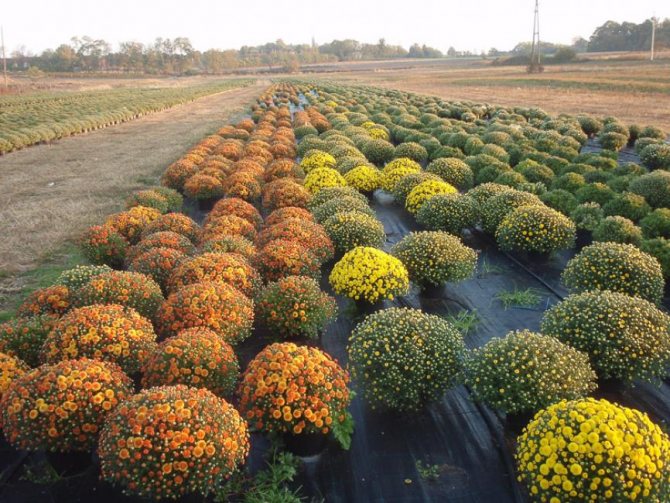

Planting with seeds is, in turn, divided into direct and transplant sowing.
Straight sowing is carried out at the end of April, or in the first days of May... It includes the following steps:
- Prepare the holes, keeping a distance of 25 cm between them.
- Pour plenty of water over them.
- Place several seeds in each well.
- Sprinkle over the crops and cover them with plastic to help the seeds germinate faster.
The second way implies growing chrysanthemum seedlings at home, followed by planting it in a flower garden. You can sow seedlings at the end of February. They do it as follows:
- Moisten the soil in the container with a spray bottle.
- Spread the seeds over the top of the soil.
- Cover the container with plastic wrap.
- Provide a temperature regime within 23-25 degrees.
- Moisten the soil periodically in the same way and lift the foil for ventilation.
- When the first leaves appear, make a dive (transplant the plants into a large container).
Seedlings are considered ready for transplanting into a flower garden if they have strong stems and a height of about 20 cm.
Another way is planting chrysanthemum shoots... It is he who is recommended by experienced gardeners.
Planting with seeds is dangerous because the chrysanthemum can lose varietal properties, so planting by shoots is always preferable.


Chrysanthemum ‘Turner’ variety.
Shoots are planted in open ground since April, they are able to tolerate small frosts. In this case, the following technology is used:
- Prepare the soil... It should be light, loose and nutritious. To increase fertility, add a mixture of humus and peat to it. But you shouldn't get too carried away with fertilizers, otherwise the plant will begin to grow strongly, and the flowering will be scarce.
- At a distance of 60 cm from each other, dig holes about 40 cm deep.
- Water them well and lay the drainage, which can be used as coarse sand. Pour fertile soil on top.
- Bury the seedling in the ground... You do not need to do this too deeply, because the root system of globular chrysanthemums is superficial.
- If you have chosen a tall variety of chrysanthemum, give her a support.
The work will not be over at this point. In order for Multiflora to grow quickly and not get sick, you need to be able to properly care for it.
What chrysanthemum seeds look like. Growing chrysanthemums from seeds
Growing chrysanthemums from seeds
Most gardeners love chrysanthemums. These vibrant autumn flowers are able to decorate any garden until late autumn. Everyone knows that chrysanthemums are propagated by dividing queen cells and cuttings. However, the topic of growing them from seeds is still not touched by anyone. So let's talk about it.
Seeds can be used to grow both annual and perennial chrysanthemums. Moreover, from perennials, mainly Korean ones are propagated in this way.
First, consider the cultivation of annual chrysanthemums. You can sow seeds directly into the garden in the open field in the month of May. To do this, make holes, the distance between which is maintained at 20 - 25 cm, spill them with warm water, put 2 - 3 seeds in each, sprinkling a little with earth. On top, you can put pieces of garden film for better heating and moisture retention. As soon as shoots appear, the film is removed, the soil is carefully loosened, the weeds that have appeared are removed. After a week, you can feed the seedlings with highly diluted liquid fertilizer (for example, "Ideal", "Rainbow"). When young plants reach a height of 5 - 10 cm and 3 - 4 true leaves appear in each hole, one of the strongest plant is left. The rest can be plucked out or deposited elsewhere.
One "but" - with such a sowing period for the flowering of chrysanthemums, you will have to wait long enough - somewhere from the beginning of August.
If you want to bloom faster, you should grow chrysanthemums through seedlings.Moreover, perennial chrysanthemums are recommended to be grown from seeds only in this way.
Seedlings are grown in a heated room (usually a city apartment or private house) or in a stationary heated greenhouse.
To do this, in late February - early March, seeds are sown in shallow boxes with an earthen mixture. The mixture can be prepared independently from the earth collected from the greenhouse, peat and humus, taken in equal quantities. It is advisable to pre-sift them and calcine them at a temperature of 110 - 130 degrees (or steam). Or you can buy ready-made land for flowers in the store. Drainage is poured into the boxes - broken brick, gravel or expanded clay and a moistened earthen mixture is poured. Seeds are scattered over the surface, and for annual chrysanthemums they are covered with earth to a depth of 0.5 cm, for perennials they are left on the surface, only slightly pressing the palm against the soil. Crops are sprayed with water from a spray bottle, covered with glass or plastic wrap and placed in a warm place with an air temperature of 23 - 25 ° C. Periodically, the crops are checked by airing them, sprayed with warm water from a spray bottle, preventing the soil from drying out. Subject to the above conditions, friendly shoots should appear in 1.5 - 2 weeks. Then the boxes are placed in the brightest place. Gradually adapting the seedlings to the environment, they remove the film first for one hour, then for two, and then remove it completely.
Rules for caring for a spherical chrysanthemum
Chrysanthemum Multiflora care includes a number of standard flower-growing activities:
- Shading... It is necessary for flowers in the first few days after planting in the ground. A fragile young plant should be protected from the bright sun by covering it with a non-woven material. At the same time, it is important to make such a design of the shelter so that it does not touch the chrysanthemum foliage.
- Watering... Multiflora is very moisture-loving; in the heat, be sure to make sure that the soil under it does not dry out. If possible, use rainwater or well-settled water for irrigation. Or add a couple of drops of ammonia to a bucket of water to soften.
- Fertilizing the soil... It must be produced in the spring, along with the beginning of the growing season. You can use mullein or humus for this. And during the period of bud formation, for a more intense and prolonged flowering, superphosphate (50g per 1 sq.m.) can be added to the ground.
- Topping... In the case of Multiflora, this procedure is optional. The plant is genetically programmed for the shape of a ball. If you suffer from perfectionism, and it is important for you to personally control the shape of the plant, then do the pinching procedure immediately after planting. Pluck the growth point from the shoot, and after 20 days repeat the procedure. The second time, it will be necessary to remove the entire upper part of the shoot with several nodes.
The multiflora variety is valued for its high resistance to most flower diseases. But it also does not have 100% immunity, therefore it needs at least minimal protection from diseases and pests.
Often, gardeners find bare lower parts of the stems and blackened leaves on chrysanthemums. This is how the powdery mildew disease manifests itself on flowers. This disease appears, mainly from improper care, which consists in waterlogging of the soil and excessive density of the bushes. If your Multiflora is affected by this disease, urgently take the following measures:
- Get rid of damaged foliage and stems.
- Replace the entire topsoil under the plants. It is in it that the spores of the fungus that cause the disease lie.
- Make a copper-soap solution and spray it on the chrysanthemums. To do this, stir 5 g of copper sulfate in a glass of hot water, and separately dissolve 50 g of soap in 5 liters of warm water. Then pour the copper solution into soapy water with a thin stream and stir everything thoroughly. Flowers are sprayed with this mixture 3 times, with a break a week.The solution can also be used for prophylaxis, treating plants with it in early summer.
Of all insects, spherical chrysanthemums are most often affected by caterpillar invasions. To prevent their appearance, spray Multflora with Intavir and Iskra chemicals, following the instructions on the package.
If you follow the rules for caring for spherical chrysanthemums, they will generously thank you with bright and long flowering. And for the successful breeding of Multiflora for many years, it is also good to learn how to propagate it yourself.
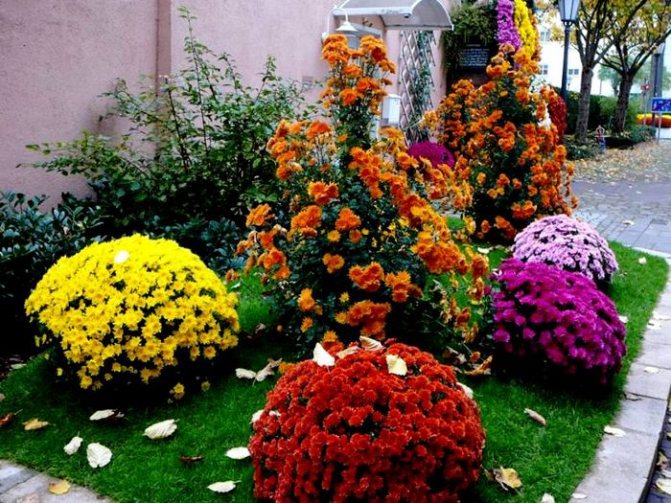

When purchasing rhizomes for planting, you need to take into account several nuances:
- It is advisable to purchase seedlings and rhizomes in the spring before planting in the ground. Thus, the quality of the planting material can be monitored.
- Before buying, you should carefully examine the rhizome: it should not have spots, rotten areas, dry fragments.


An excellent time to plant a globular chrysanthemum is early spring, when young grass appears. The soil has warmed up so much that it can be dug up. Before planting rhizomes, they need to be woken up. To do this, they are placed in a large container and sprayed with settled water. So leave them in a bright place, protecting them from direct sunlight. After 3-4 days, after the emergence of sprouts, they are planted.
Reproduction of chrysanthemum Multiflora
There are three ways to reproduce globular chrysanthemums:
- propagation by cuttings;
- dividing the bush;
- division of the root system.
The first method should be started in spring., at the moment when it's time to get Multiflora after wintering. Place the box with roots in the sun and moisturize the soil regularly. Over time, new shoots will grow from the buds. When they reach a length of 10 cm, the bush is divided, and individual shoots are planted in open ground. This method not only allows chrysanthemum to propagate, but also rejuvenates the plant. Old bushes that have not been separated for a long time lose their decorative properties over time.
Tip: Multiflora also reproduces well with green cuttings. Cut them from the plant and keep them in water until roots appear, then plant them in the ground.
The remaining two methods allow chrysanthemum to be propagated by transplanting. You can transplant Multifora both at the end of summer and in autumn.... The main thing is to give it the opportunity to take root well before the first frost. And you can save your time and plant young plants immediately in pots for wintering indoors.
By learning how to grow globular chrysanthemums, you can create many beautiful interiors for your garden with them. The variety of Multiflora is impressive, consider the most popular varieties of this variety.
Watering and fertilizing rules
When growing this plant, it must be properly watered. In the summer, the plant loves frequent, but not plentiful watering. This helps to make the shrub lush and protects young shoots from lignification.
If we talk about the choice of water, then water that is settled or collected during the rain is suitable for chrysanthemums.
Experienced growers say that it is better to under-feed these flowers than over-feed them. It is recommended to fertilize bushes once. - only at the beginning of the season, that is, in the spring. Organic fertilizers are considered the best feeding - mullein, humus. When the bushes look weak, you can feed them with phosphorus-potassium fertilizers, but this can be done with unformed buds.
Water-charging chrysanthemums in autumn
Do not forget that perennials can freeze in winter not only due to low air temperatures, but also due to lack of moisture, since dehydrated crops cannot fully withstand adverse weather conditions.
Of course, chrysanthemum during autumn flowering needs regular watering, the volume and frequency of which you must regulate yourself depending on the weather conditions, so that the flowers do not dry out and the roots do not rot in the cold soil. After watering, the soil should be loosened to prevent excessive evaporation of moisture and to enrich the soil with oxygen. At the same time, destroy the remains of weeds.
Before the onset of cold weather, it is worth carrying out the final water-charging watering of chrysanthemums at the rate of at least 5 liters of water for each bush. Then the plants will be able to gradually absorb water from the soil during the winter.A layer of mulch, which you will use to insulate the roots later, will help keep moisture in the soil until spring.
The nuances of growing flowers
A distinctive feature of spherical chrysanthemums is that they are not planted and propagated with the help of seeds, since such "children" do not have varietal characteristics. This makes it almost impossible to get classic flowers, the result can be the most unexpected.
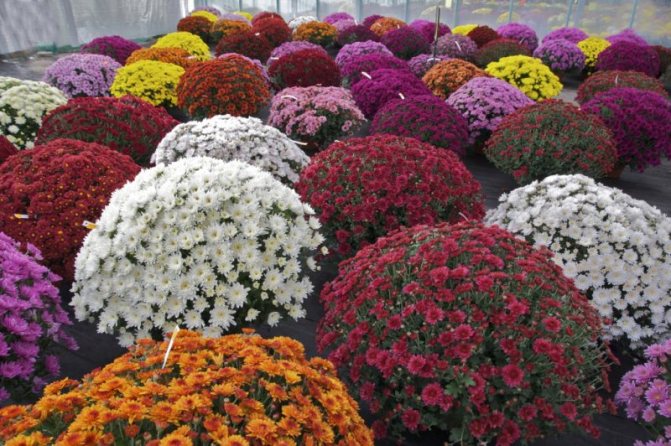

Therefore, for this plant, the method of cuttings and the use of dormant rhizomes are used. Thanks to this, the flower will most likely grow to the required size and bloom on time.
However, with such growing methods, gardeners, especially beginners, should pay attention to the following nuances:
- Planting material should only be purchased in the spring, when the planting season begins. This will help ensure the quality of the material and save you from buying non-viable flowers.
- You should carefully examine the rhizomes before purchasing. They must not have stains or signs of rot and must not give the impression of being dry.
The flower should be planted in the spring, after the first grass appears. It is important to make sure that the soil is not frozen and there will be no difficulty in digging.
A distinctive feature is that chrysanthemums can be planted in pots. It is only important to properly prepare the soil.
- To do this, mix peat and earth, additionally add sand (1/4 of the total volume).
- Drainage is laid out at the bottom of the pot.
- And only then the planting mixture is poured.
The volume of the planting container must be at least 5 liters for one seedling
Why are these flowers so popular with gardeners?
But these flowers won the hearts of gardeners not only with their fabulous appearance:
- Unlike other varieties, they often bloom even at the end of August, delighting flower growers all autumn.
- Due to their unique genetic properties and constant selection, they do not require any pruning and shaping at all: the bush acquires a spherical shape completely independently. But some experts say that it is more useful to pinch the tops when about four pairs of leaves appear on them. However, in 90% of cases, this event is not necessary, since the spherical chrysanthemum will acquire the necessary outlines without your intervention.
- In addition to the vegetable garden and garden, the bushes of this amazing plant feel great even on the windowsill, being planted in flower pots. In a word, they are everywhere capable of becoming a real decoration of the area, attracting admiring glances to themselves.
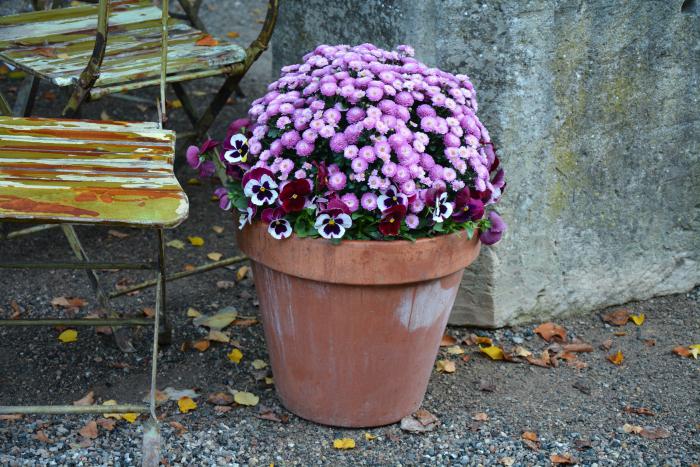

The only obstacle for beginners may be their wintering, which requires certain conditions and care.
Pruning globular and dwarf species
Depending on the variety of autumn flowers, different methods of pruning and storage are used until spring.
Spherical
Almost all ball varieties of autumn flowers were bred for potting. These flowers are a decoration of balconies, terraces, gazebos. Some practice planting them in flower beds and front gardens.
Perennial winter-hardy varieties that grow outdoors in summer are enough to cut and sprinkle with a thick layer of straw or spruce branches. This shelter is suitable for plants cultivated in the southern zone. In the regions of the Middle and Central lane, it is necessary to wait until the bushes have faded, then cut them to a height of 5-6 cm from the surface of the soil, dig them up, dry them in a shaded place, clean them of soil residues and place them in pots or containers filled with straw or sawdust.
You can store the bushes until spring in a cool room with good ventilation, an air temperature of about 1-3 ° C and a humidity of 60%.
Dwarf
These varieties of garden chrysanthemums are intended for home planting.Before the onset of winter cold, shoots are trimmed at a height of 10 cm from the soil surface. Then the bushes are placed in a bright room, where the temperature is kept at 10-12 ° C. Dwarf bushes are watered no more than once a month.
A little about the "Koreans"
Despite the general unpretentiousness of this variety of flowering plants, even among them there are varieties that are especially suitable for growing in our conditions. These are spherical Korean chrysanthemums.
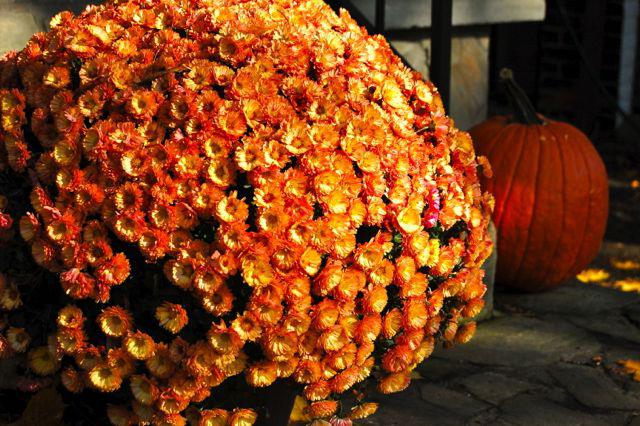

This variety is hybrid. It is divided into several types at once. The first group includes border varieties, the height of which does not exceed 30 cm. They are ideal for decorating a personal plot, since they are distinguished by very early flowering periods, almost complete absence of root growth and the most spherical shape of the bush.
The second type is medium-sized chrysanthemums, the height of which reaches about 50 cm. They are extremely decorative, since among the plants of this group there are varieties with an extremely diverse color of inflorescences.
They are great for creating a variety of group compositions. Unlike the first group, they can be used for cutting. In addition, they may well be cultivated as houseplants.
The third group includes all tall varieties. They are distinguished by late flowering, large inflorescences. Perfect for large areas. Despite its impressive size, the bush is quite compact.

